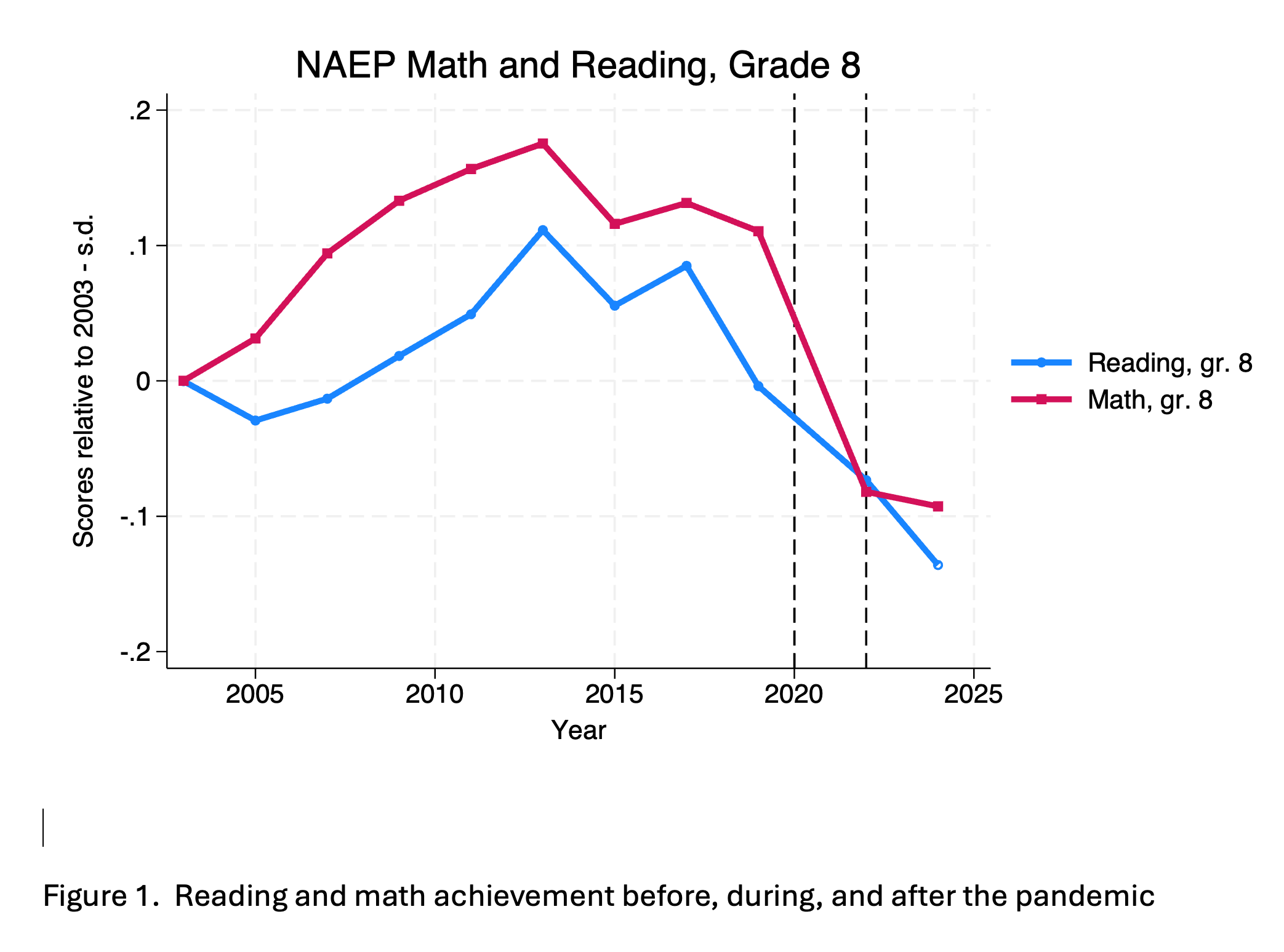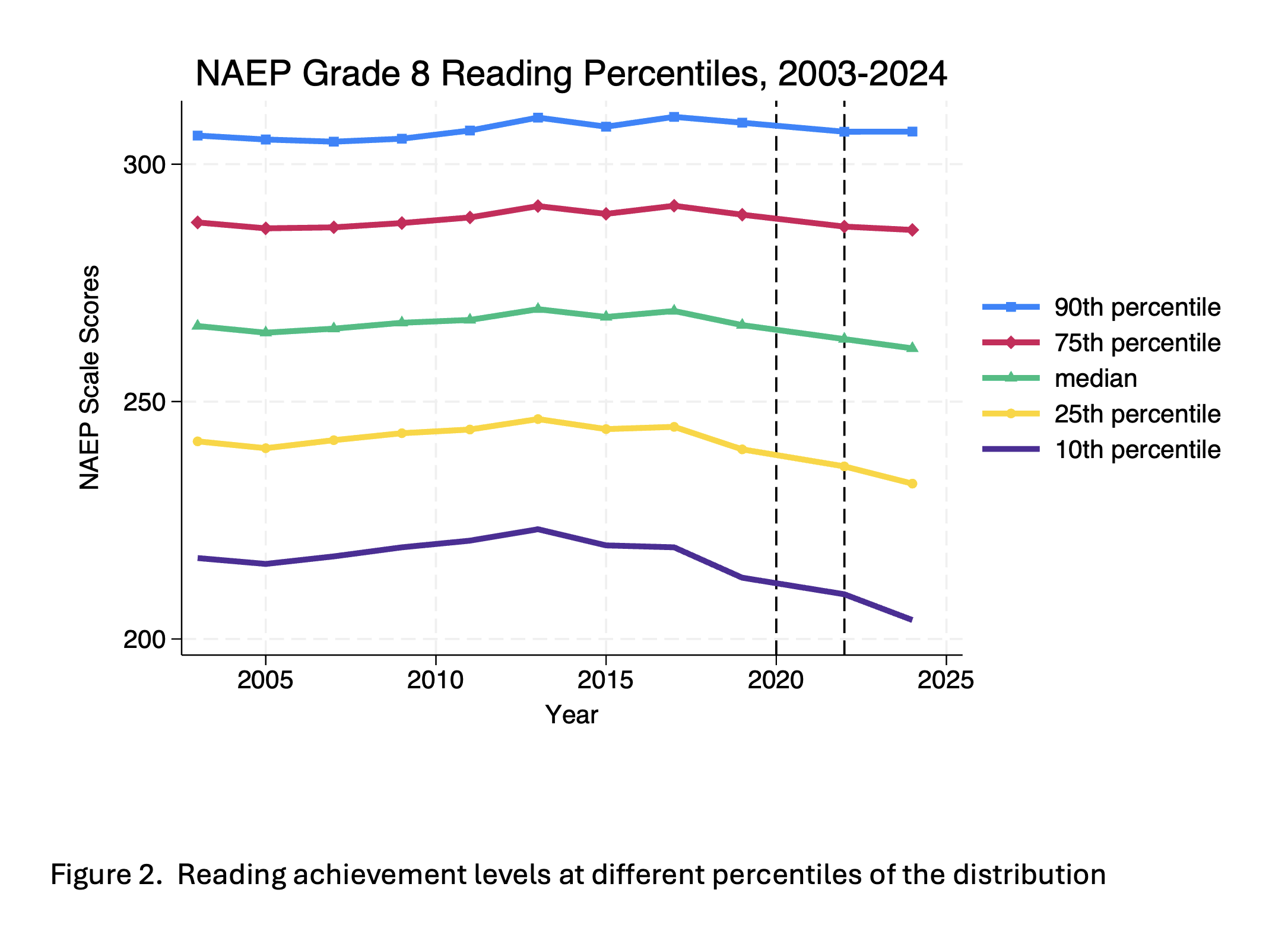The COVID-19 pandemic was bad for anybody in school at the time. Schools closed, teachers struggled with remote and hybrid instruction, and the return to normal, in-class routines was delayed and wildly uneven. There’s no question that all of this harmed students’ learning trajectories. But while educators rushed to address COVID learning losses, few Americans grasped that their children had already been falling behind for almost ten years. By 2019, before anyone had ever heard of Wuhan, N95 masks, or social distancing, eighth-grade math scores had already dropped to levels not seen since the early 2000s. And the declines continue.
The pandemic’s disruption of schools dwarfed anything seen in the postwar period, and the potential damage to learning could not be ignored. Resources flowed, and programs sprang up. The wide range of policies designed to help the COVID cohort generally try to make schools look as close as possible to what they looked like before the pandemic—and then add some short-run, remedial programs to fill in any gaps caused by pandemic losses. States and local districts have focused on more time—longer days, more days, and summer school—along with a variety of approaches to focused tutoring.

But it’s time to look past pandemic remedies to more fundamental problems.
The pre-pandemic school system was in steady decline, and building on it was never likely to be a viable recovery strategy. A half century of experience indicates that dealing with the residual problems of the pandemic, that improving schools to be globally competitive, and that narrowing the existing achievement gaps each requires deeper changes in the incentives that drive achievement.
The achievement story
The National Assessment of Educational Progress (NAEP), often referred to as the “Nation’s Report Card,” is designed to measure student performance consistently over time. NAEP provides regular assessments of reading and math for state-representative samples of fourth- and eighth-graders. The pattern of achievement charted by NAEP over the past two decades provides a foundation for policy discussions around the pandemic.
A crude way to judge the impact of the pandemic is to assume that a cohort—say, the eighth-graders in school during the pandemic—would have achieved what those in the same grade before the pandemic achieved. The fall in NAEP assessments between 2019 and 2022 sparked a variety of such analyses. But a more comprehensive picture requires looking also at students’ performance before and after the pandemic.
Both math and reading performance began falling after 2013, well before the start of the pandemic. As seen in figure 1, scores for eighth-graders rose in the beginning of the century but started falling in 2013. The fall was more precipitous during the pandemic period (2019–22) but continued in the “recovery period” (2022–24). The average math and reading decline from 2013 to 2024 was 0.28 standard deviations. Just half of this occurred in 2019–22.

The decline in scores has also been accompanied by a widening of the achievement distribution: lower-achieving students have suffered greater declines than those at the top of the achievement distribution. And, again, while the pandemic led to public concerns about disparate impacts on disadvantaged students, this increased spread in learning actually began in 2013 and continued through 2024 (figure 2).

Individual state patterns generally follow similar time trends but differ in magnitude. Almost three-quarters of the states had reached their highest level of eighth-grade NAEP student math achievement by 2013. Two-thirds of the states had also reached peak reading scores by that year. But while the combined math and reading declines from peak were held to 0.1 standard deviations in Louisiana, the District of Columbia, and Mississippi, they reached one half standard deviation in Vermont and Delaware.
The most recent NAEP data for grade twelve, reported in September, while not separating the pandemic period from the recovery period, tell the same story. Math performance peaked in 2013 and fell continuously through 2024 by 0.19 standard deviations; half of the decline had occurred by 2019. Reading fell from the 2013 peak by 0.14 standard deviations, and again, half by 2019. These tests, arguably more important than eighth-grade scores because they measure performance at the time of leaving high school, also show a widening of the score distribution since 2013.
A variety of other assessments back up the findings. NAEP provides assessments for the nation (but not the individual states) that go back to the 1970s. In these measurements, scores for 13-year-olds (seventh- or eighth-graders) peaked in 2012 for both math and reading. By 2023, math had fallen back below scores in 1992, and reading scores had fallen to the level seen in 1975.
The prior peaks in scores also show up on international tests: TIMSS for eighth-graders and PISA for 15-year-olds. The international tests, of course, also compare the performance of US students to those elsewhere in the world. PISA math scores in 2024 put American students in thirty-fourth place among participants—below the OECD average, edging out the Slovak Republic but falling behind Malta.
Economic consequences
The economic costs of the falloff in learning are huge. While changes in standard deviations may be hard to grasp, it is far less difficult to understand the economic implications of changes in the skills measured by the tests.
Research makes it clear that on average, individuals who know more earn more. It also shows that nations with a more skilled workforce—what has been labeled the “knowledge capital” of nations—grow faster in the long run.
Students in school over the past decade will, according to historical evidence, have future earnings that are on average lower by almost 8 percent for their entire working life when compared to those of students in 2013. Again, the pandemic losses represent just half of this. Further, disadvantaged students, whose average achievement declines were larger, can thus expect even larger income losses.
For the nation, the expected costs of the learning declines make many of the current economic and fiscal discussions appear inconsequential. Using historical growth relationships to compare where the US economy would be had we stayed at the previous peak achievement levels, the present value of future expected GDP growth would be approximately three times current GDP (which is $30 trillion). GDP on average would be 6 percent higher for all years in the remainder of the century if we were able to stay at the achievement levels of 2013. These losses are many multiples of the combined GDP losses due to the 2008 recession and the COVID recession.
Much of the education discussion early in the pandemic revolved around the need not just to return to the pre-pandemic schools but also to make them better. Few people were happy with the pre-pandemic achievement levels.
What success would look like
In 1983, the benchmark report A Nation at Risk: The Imperative for Educational Reform made an observation still appropriate today:
The time is long past when America’s destiny was assured simply by an abundance of natural resources and inexhaustible human enthusiasm, and by our relative isolation from the malignant problems of older civilizations.
In the four decades since, we have seen many attempts to meet the report’s challenges. The reforms include expanded graduation requirements, better pay for teachers, smaller classes, school accountability with meaningful consequences, expanded preschool, new curricula and technologies, different forms of governance, charter schools and other choice options, “wraparound services” for students, and substantially increased funding.
The results are underwhelming. Most of the reforms are incremental and isolated, moving one part of the existing system with little concern about other parts or other reforms. Then, even if a policy approach shows effectiveness, it fails to be implemented broadly and generally it dies or is pushed aside by new reforms.
The details of each new reform differ, but the repeated failures of the broad set of reforms to deal with the nation’s achievement challenges are remarkably consistent. What causes failure? As mentioned above, the underlying theme of reform efforts over the past half century is to enhance particular features of the educational system while retaining the essence of the institutional structure. The result is a collection of add-ons of various types, regulatory constraints designed to prevent poor outcomes, and pure expansions of existing resources that, even when viewed as promising, fail to yield the hoped-for results.
Incentives are generally not aligned to higher student achievement. This leads to a system that may or may not adopt programs, policies, and operations that support better performance. Among the programs that work are incentive-based personnel changes in Washington, DC, and Dallas. We learn from these good examples that when teachers are evaluated and paid based on their classroom effectiveness, student scores respond significantly. Yet these systems are largely not copied. There simply are not strong incentives for others to emulate success.
One model is available from the Education Futures Council and provides an example of how the system might change. This report calls for focusing steadily on student outcomes, incorporating incentives for the desired outcomes, and recognizing that local capacity and local demands vary so much that broad mandates and regulations thwart innovation.
Because schooling is local, this model maintains that federal roles should be confined to support, not control, while including efforts such as data collection and research, and to using incentive-based approaches instead of mandates and regulations. States are central to enabling local implementation but should not treat all districts the same. For example, districts that perform well should be given wide operational latitude in actions, while districts that do not perform well should be more closely constrained and guided to more successful outcomes.
There are, of course, many alternatives to the current structure of our educational system. A half century’s collection of highly touted marginal changes to schools, however, simply has not worked. History suggests that we should look more to an outcome-based design than to small tweaks of our current stagnant system. Only then can we get to the systemic causes of a decade-long decline that persists long after the COVID trauma has come and gone.
Eric Hanushek is the Paul and Jean Hanna Senior Fellow at the Hoover Institution of Stanford University. He is internationally recognized for his economic analysis of educational issues, and his research has had broad influence on education policy in both developed and developing countries. He received the Yidan Prize for Education Research in 2021.
